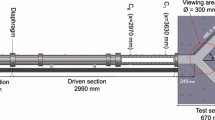Abstract
The problem of shock bifurcation observed for a reflected shock interacting with a boundary layer is investigated both experimentally and numerically. The process has been visualized by means of color schlieren photographs that clearly show the characteristic wave pattern. Accompanying pressure measurements hint at the three-dimensional character of the wave system. In a numerical scheme based on the Euler equations the problem has been simulated giving good agreement between the calculated and the observed wave configuration.
Access this chapter
Tax calculation will be finalised at checkout
Purchases are for personal use only
Preview
Unable to display preview. Download preview PDF.
Similar content being viewed by others
References
Davies L (1967) The interaction of the reflected shock with the boundary layer in a shock tube and its influence on the duration of hot flow in the reflected-shock tunnel. Part I, ARC C P 880
Fokeev VP, Gvozdeva LG (1989) Study of bifurcation of reflected shock waves in channels of various cross-sections. In: Kim YW (ed) Proc 17th Int Symp on Shock Waves and Shock Tubes, Bethlehem, AIP, New York, pp 862
Honda M, Takayama K, Onodera O, Kohama Y (1975) Motion of reflected shock waves in shock tube. In: Kamimoto G (ed) Proc 10th Int Shock Tube Symp, Kyoto, Shock Tube Research Soc Japan, pp 320
Kleine H, Gronig H (1991) Color Schlieren methods in shock wave research. Shock Waves 1:51–63
Lyakhov VN, Podlubnij VV and Titarenko VV (1989) Interaction of shock waves and jets at the elements of construction. Maschinostojenie, Moscow
Mark H (1958) The interaction of a reflected shock wave with the boundary layer in a shock tube. NACA TM 1418
Takano Y (1987) Simulations for effects of side-wall boundary layer on reflected shock flow fields in shock tubes. In: Gronig H (ed) Proc 16th Int Symp on Shock Tubes and Waves, Aachen, VCH Weinheim, pp 645
Taylor JR and Hornung HG (1981) Real gas and roughness effects on the bifurcation of the shock reflected from the end wall of a tube. In: Treanor CE, Hall JG (eds) Proc 13th Int Symp on Shock Tubes and Waves, Niagara Falls, State University of New York Press, Albany, New York, pp 262
Author information
Authors and Affiliations
Editor information
Editors and Affiliations
Rights and permissions
Copyright information
© 1992 Springer-Verlag Berlin Heidelberg
About this paper
Cite this paper
Kleine, H., Lyakhov, V.N., Gvozdeva, L.G., Grönig, H. (1992). Bifurcation of a reflected shock wave in a shock tube. In: Takayama, K. (eds) Shock Waves. Springer, Berlin, Heidelberg. https://doi.org/10.1007/978-3-642-77648-9_36
Download citation
DOI: https://doi.org/10.1007/978-3-642-77648-9_36
Publisher Name: Springer, Berlin, Heidelberg
Print ISBN: 978-3-642-77650-2
Online ISBN: 978-3-642-77648-9
eBook Packages: Springer Book Archive




